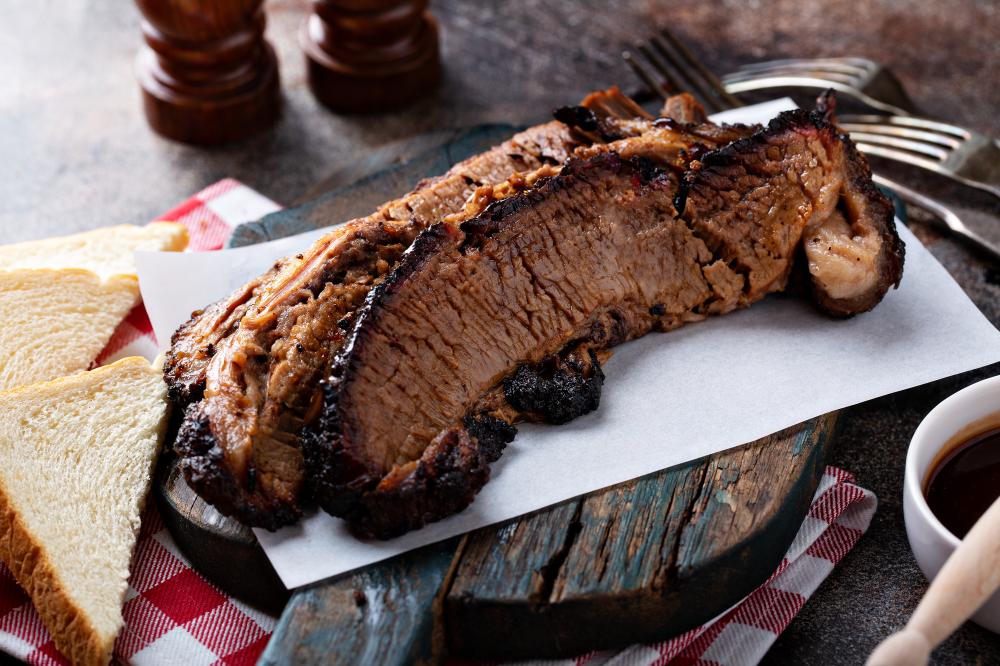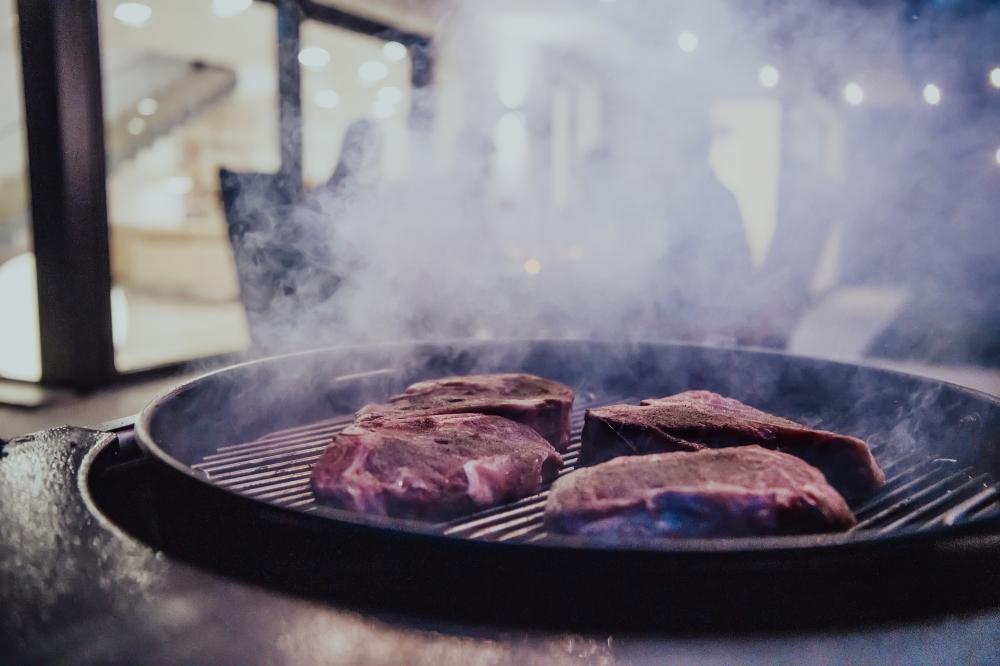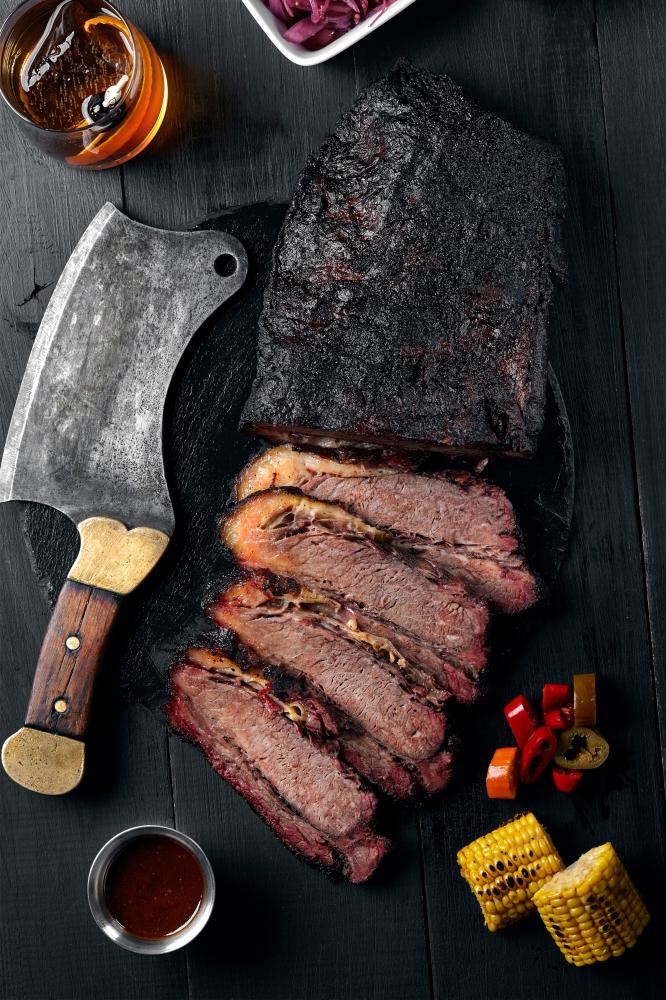
Optimal Temperature Guide
At Brisket Pro, we often get asked, “What temp to pull brisket and put in cooler?” It’s a question that carries the weight of your brisket’s success on its shoulders. The sweet spot for pulling your brisket off the heat and transferring it to a cooler hinges around 200°F to 205°F. It’s not just a number; it’s the pivotal moment when the brisket has reached its peak tenderness, having given the connective tissues and fats ample time to break down and mingle.
Every brisket whisperer has their magic number, with some swearing by the precise 203°F mark. In my own smoking escapades, I’ve found that this range not only ensures your brisket is exquisitely tender but also maintains a juicy interior courtesy of perfectly rendered fat.
Resting Methods
Resting in a Cooler: The Faux Cambro Method
The shift from smoker to cooler is not just a change of scenery for your brisket but a vital rest period. I wrap my briskets in a couple of towels before nestling them into a cooler prepped for the task. This method, known affectionately as the Faux Cambro, maintains the temperature, allowing the brisket’s internal magic to continue. The towels act as an extra insulation layer, absorbing any rogue drippings and easing cleanup. Learn more about how long to let brisket rest before cutting when you explore our website.
Opting for a quality cooler is key. High-end models like Yeti or RTIC are excellent at retaining heat, but truthfully, any well-insulated cooler you have handy can do the trick. What’s crucial is maintaining the brisket’s internal temperature above the danger zone and ensuring it doesn’t cool down too rapidly.
Alternative Resting Techniques
Not all briskets rest the same, and sometimes, a cooler isn’t part of the equation. For briskets that I plan on slicing and serving within a shorter window, a simple room temperature rest suffices, ideally keeping that rest under an hour to prevent entering the bacterial danger zone. On the flip side, when I’m looking for an extended rest or dealing with larger cuts, specialized equipment like a Cambro or a steam cabinet can be invaluable. These tools offer precise temperature control, ensuring your brisket stays within that tender, juicy ideal.
To Wrap or Not to Wrap
When pondering the question of What temp to pull brisket and put in cooler, it’s also essential to consider whether you’ll rest your brisket wrapped or unwrapped. If you’ve embraced wrapping during the cook–be it with aluminum foil or butcher paper–keeping it wrapped during its cooler sojourn can be beneficial. The wrap serves as an additional insulation barrier, trapping in those precious juices and fostering a mini environment where carryover cooking can gently proceed, further tenderizing your brisket.
The Significance of Resting
The resting phase isn’t just a pause in action; it’s a continuation of the cooking process. Think of it as the brisket’s time to relax, allowing the redistributed juices to seep back into every fiber, ensuring each slice is as moist and flavorful as possible. Rushing this stage can result in a drier, less satisfying brisket, where all your hard work literally ends up on the cutting board instead of in the meat.
Whether you’re letting your brisket rest for a couple of hours in a cooler or employing different methods, patience pays off in dividends. Remember, the true essence of barbecue lies not just in the flavors but in the journey of preparation. From the perspective of a brisket aficionado, there’s nothing more rewarding than slicing into a perfectly rested brisket, knowing it’s reached its zenith of texture and taste.
Personal Insights
In my years of smoking briskets, I’ve seen firsthand the difference that proper resting makes. There’s a noticeable contrast in texture and juiciness between briskets rushed to the plate and those given time to properly rest. Each time I’m asked What temp to pull brisket and put in cooler, I emphasize the importance of not just the temperature, but the method and patience required afterward. One of my most memorable brisket experiences was when I let a particularly stubborn cut rest for nearly eight hours in a cooler during a competition. The result was nothing short of miraculous, achieving a tenderness and flavor profile that I still chase to this day.
Respecting the rest phase of your brisket isn’t just about following directions; it’s about understanding and appreciating the transformation that occurs within. Whether you’re aiming for competition glory or simply looking to impress family and friends at a backyard BBQ, the principles remain the same. What temp to pull brisket and put in cooler? It’s more than just numbers–it’s the foundation of brisket mastery.

The Importance of Resting Brisket
At Brisket Pro, we often emphasize the step that transforms a good brisket into a great one: resting. Many ask us, ” How long to let brisket rest?” It’s a simple question with a nuanced answer. Letting your brisket rest is crucial for achieving that perfect blend of juicy tenderness and flavor, and here’s why.
When a brisket comes off the smoker or grill, it carries residual heat that continues to cook the meat, a phenomenon known as carry-over cooking. During this time, the fibers of the brisket, which have tightened during the cooking process, begin to relax and reabsorb the juices distributed throughout the meat. This process results in a brisket that is much more moist and flavorful when finally served.
The optimal resting time can vary, but as a rule of thumb, we recommend a rest period of at least one hour. However, for the juiciest results, aim for two hours. This allows ample time for the brisket to properly cool and reabsorb those tasty juices.
Methods for Resting Brisket
Understanding how to rest your brisket properly can make a world of difference in the final outcome. Let’s dive into some practical tips.
Wrapped versus Unwrapped
There’s a debate among brisket aficionados about whether to rest the brisket wrapped or unwrapped. If you’ve used the Texas Crutch method (wrapping the brisket in butcher paper or foil during the stall), you might consider keeping it wrapped during the rest period. This method helps maintain the meat’s temperature and moisture. However, if your goal is to preserve a crispy bark, allowing the brisket to rest unwrapped in a cooler environment can prevent the crust from softening too much.
- Room Temperature: Letting the brisket rest at room temperature is suitable if you plan to serve it within a couple of hours. Place it on a wire rack over a baking sheet to catch any drips and allow air to circulate around the brisket.
- Cooler or Faux Cambro: If you’re not serving the brisket immediately, keeping it in a cooler or insulated box can keep it warm for several hours without overcooking it. Wrap the brisket in a towel over the foil or butcher paper to insulate further and place it in the cooler.
Factors Influencing Rest Time
The question of “How long to let brisket rest” doesn’t have a one-size-fits-all answer. It depends on several factors, including the size of the brisket and the cooking method used. A larger brisket, for instance, retains heat longer and may benefit from a longer rest time. Similarly, briskets cooked at higher temperatures might need more time to relax and reabsorb juices.
Personal preferences also play a significant role. Some BBQ masters prefer a longer rest for a softer texture, while others may prioritize serving the brisket slightly firmer. Experimenting with different rest times can help you discover what works best for you and your tastes.
In my experience, the patience involved in resting a brisket is almost as important as the cooking process itself. I’ve found that briskets rested for two hours tend to yield the most consistent results in terms of flavor and tenderness. Regardless of the method you choose, always use a meat thermometer to ensure your brisket doesn’t drop into the danger zone (below 140°F) to prevent any food safety issues.

What temperature do you take brisket off and put in cooler?
At Brisket Pro, we often recommend pulling your brisket off the smoker and transferring it to a cooler when it reaches an internal temperature of around 200°F to 205°F. This is the sweet spot where the magic happens – connective tissues break down, fats render perfectly, and the brisket achieves peak tenderness. Some brisket aficionados swear by 203°F as their go-to number. Remember, every brisket behaves a bit differently due to variations in size, fat content, and texture, so it’s also valuable to pay attention to the feel of the meat. It should be probe tender, meaning a thermometer or skewer slides in with little resistance, similar to butter. This nuanced approach ensures that your brisket is not just cooked, but perfected.
How long to let brisket cool before putting in cooler?
When moving your brisket from the smoker to the cooler, the transition should be pretty swift. There’s no need to let the brisket cool down before placing it in the cooler; in fact, you want to capture and retain as much of that internal heat as possible. Wrapping the brisket in butcher paper or aluminum foil (if it isn’t already wrapped) and then placing it in the cooler bolstered with towels for insulation will help maintain its temperature for the extended resting period. This technique is crucial for achieving that melt-in-your-mouth tenderness BBQ enthusiasts crave. By skipping a cooldown phase before the cooler, you harness the brisket’s residual heat, promoting a gentle, ongoing cook that’ll tenderize it further.
Can I pull brisket at 190?
Pulling a brisket at 190°F is a bit on the early side for most brisket recipes. While every smoker has its quirks, and every piece of meat its unique characteristics, most briskets benefit from reaching that 200°F to 205°F range before the wrap and rest. At 190°F, the collagen in the brisket’s connective tissue is still in the midst of its transformation into gelatin, which is what gives brisket its signature succulent texture. While you might get a decent brisket pulling it at this temperature, patience will reward you with something truly special if you wait for that optimal temp range. It’s not just about hitting temperatures; it’s about ensuring the brisket has fully surrendered all its potential tenderness and flavor.
What temperature do you pull brisket after wrapping?
If you’ve chosen to wrap your brisket during the cook, which is often referred to as the ‘Texas Crutch,’ the temperature to pull it off the smoker doesn’t change. You’re still aiming for that 200°F to 205°F range. Wrapping can accelerate the cooking process by trapping moisture and heat, potentially pushing through the stall phase faster, but the end-goal temperature remains the same. The key is gentle patience, allowing the brisket to reach that tender sweet spot slowly. Whether wrapped in butcher paper or aluminum foil, the focus should be on the internal temperature and the feel of the meat. This approach ensures a brisket that’s not just cooked but transformed into a mouth-watering masterpiece.
Resources
- FoodSafety.gov – Find information on safe minimum cooking temperatures to ensure your brisket is cooked properly.
- Beef It’s What’s for Dinner – Discover beef cooking times and techniques for the perfect brisket.
- Serious Eats – Learn more about sous vide and smoked barbecue brisket techniques for optimal results.
